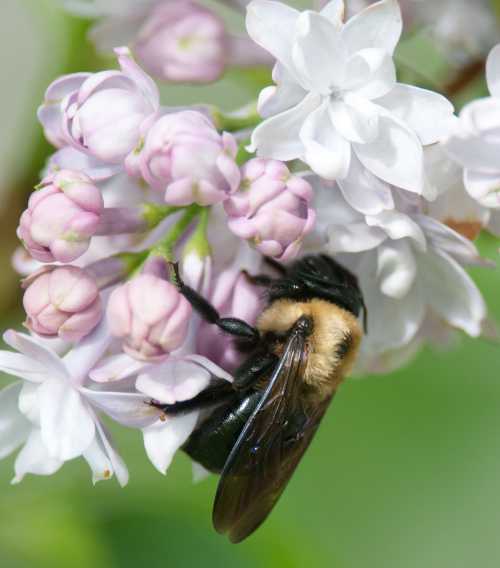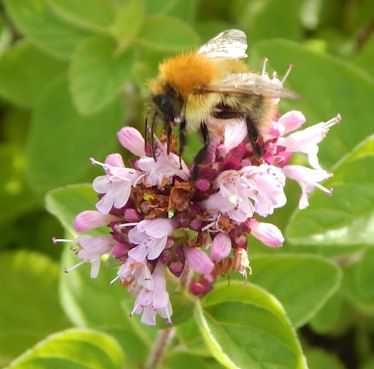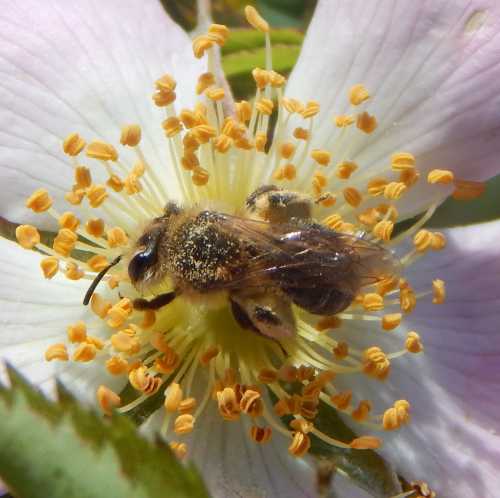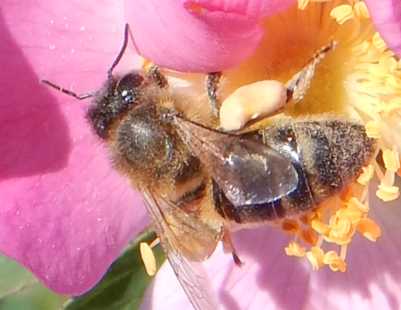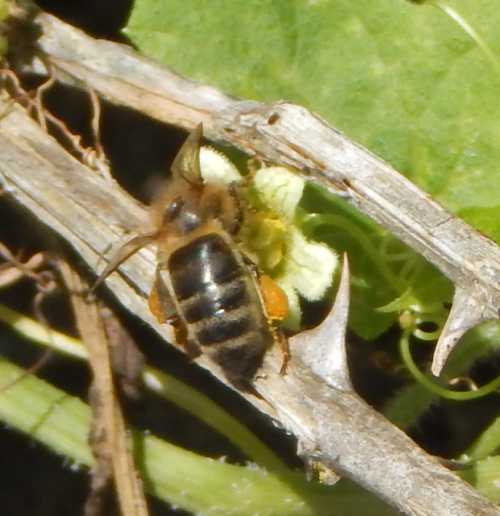How Do Bees Taste?
Updated: November 2023
You may have seen honey bees poking their tongues into flowers, and wondered whether honey bees taste with their tongues as we do. Honey bees have taste buds not only on their tongues, but in a number of locations on their bodies!
6 Tantalizing Facts About How Honey Bees Taste
- The 'taste buds' of honey bees are actually taste sensors which look a little like tiny hairs.
- These taste sensors are located on their antennae, their mouth parts, and on their front feet (yes, bees also use their feet to taste things!).
- The tips of honey bee antennae have over 300 taste sensors, and are more sensitive than the tongue!
- Scientists have found that honey bees are especially sensitive to the taste of sweet things (sugars) and salty tastes.
- Honey bees stick their tongues out when offered something potentially appetizing!
- The sense of taste is especially important for honey bees for things like gathering food and recognizing fellow colony members.
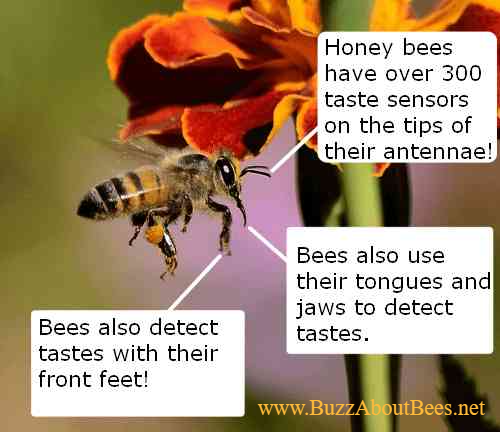 How do honey bees taste? Honey bees have taste receptors on their antennae, mouth parts and front feet.
How do honey bees taste? Honey bees have taste receptors on their antennae, mouth parts and front feet.Now for more information......
Why is taste important for bees?
4 ways in which honey bees use the sense of 'taste'
The sense of taste is very important for a variety of reasons:
1. Choosing good food sources
Bees use their sense of taste to enable them to detect the differences between things that are edible. It also may help them to detect the nutrient value of the pollen and nectar they are gathering.
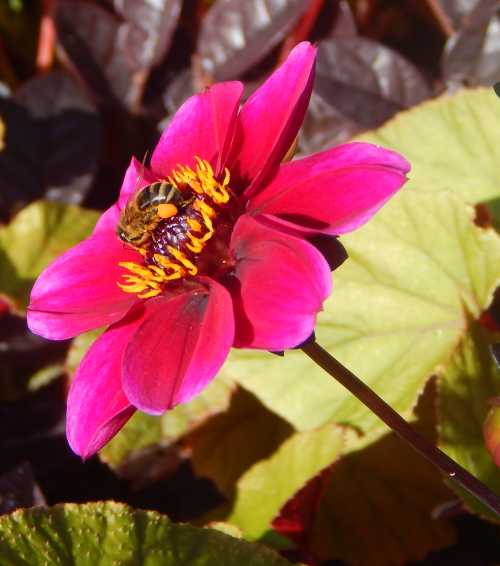 Honey bee - Apis mellifera on dahlia.
Honey bee - Apis mellifera on dahlia.For example, bees can detect the ‘sweetness’ value of a food, which is usually an indicator of the amount of sugar.
Sugars (carbohydrates) provide bees with their energy. The ability to select high sugar nectar is important for bees because they use a lot of energy relative to their size for their daily survival, in activities such as flying, vibrating their wings, tending the colony and larvae etc.
Other nutrients in pollen, such as amino acids and proteins are important for developing larvae. Research suggests that honey bees are able to detect differences in protein value between different pollens.
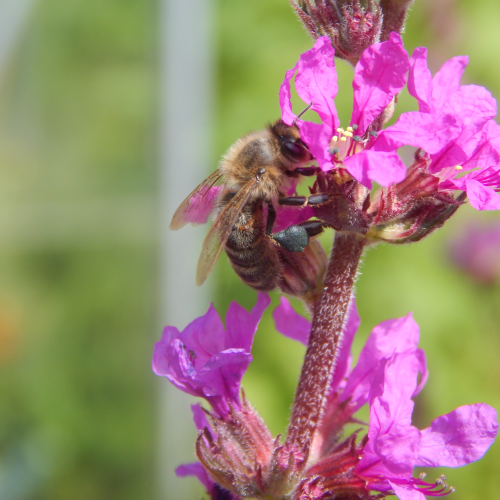 Honey bee - Apis mellifera on purple loosestrife.
Honey bee - Apis mellifera on purple loosestrife.2. Nest mate recognition in the colony
Each honey bee colony has its own unique 'chemical signature' which colony members use to recognize each other, as well as detect bees from other colonies.
Communication between bees is based on chemical signals, and these are transmitted via taste and scent when bees feed and groom each other (this includes the larvae, drones and queens).
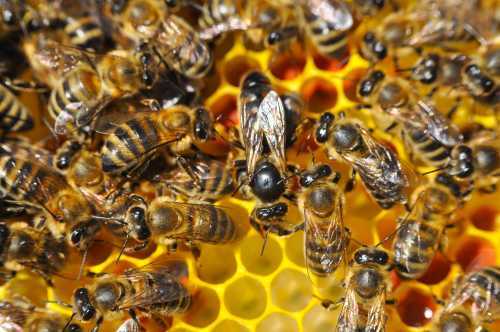 Honey bee - Apis mellifera workers with queen.
Honey bee - Apis mellifera workers with queen.3. Identifying water sources
Honey bees use water for diluting honey stores and temperature control in the nest or hive.
Interestingly, honey bees often prefer slightly salty water, and it has been found that salts are important for the development of larvae.
4. Identifying and collecting other materials
The sense of taste can be important when collecting other things, such as resins used for nest construction and protection.
Do honey bees have ‘taste buds’ to taste with?
‘Taste buds’ are also known as ‘taste receptors’ or ‘taste sensors’, and they are responsible for detecting and identifying different taste sensations (stimuli).
Of course, the tongue is considered to be most important for the sense of taste in humans. In the honey bee, the taste receptors look a bit like hairs, and these sensors are found on:
- the antennae,
- mouthparts, and
- the front tarsi (feet).
Central processing of taste occurs mainly in the central
nervous system in the subesophageal ganglion, but the nature of this processing
remains unknown.
The subesophageal ganglion is located below the
oesophagus, inside the head. Read about honey bee anatomy.
What kinds of flavours can honey bees taste?
Honey bees respond with varying sensitivity to sugars, salts, and possibly amino acids, proteins, and water.
It seems bees naturally avoid highly concentrated bitter tastes.
How do we know bees can taste, and how did scientists discover where taste receptors on bees are located?
In scientific experiments, bees automatically stick their tongues out when they sense the presence of food. For bees, this is an automatic reflex (it’s actually called a proboscis extension reflex [PER]).
Scientists devised experiments in which they stimulated the legs, antennae and mouth parts with different tasting foods, and found that bees automatically stick out their tongues in response to acceptable tastes.
For example, if antennae were presented with a suitable food, the honey bee was observed to stick out its tongue.
Scientists have also been able to view the reactions of the actual taste buds (or taste receptors) in each area, using a very powerful microscope, in response to different tastes.
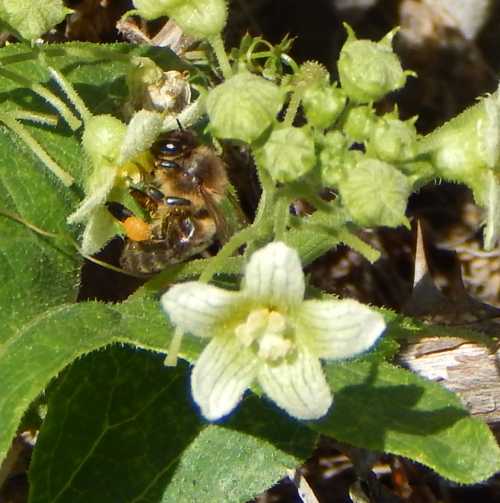
Tasting
with the antenna
Interestingly, scientists found that in honey bees, the taste sensors on the very tip of the antennae are more sensitive than those actually on the tongue (and more sensitive than those on the feet)!
Scientists have counted over 300 taste-sensing hairs on the antennae, so what role do the antennae play? Antenna are especially important for locating potential food sources. This is called ‘appetitive food sensing’.
I wonder whether this could also explain why bees sometimes linger a moment close to a flower, only to fly off without entering it – especially if the flower has been visited only moments before by another bee that has already taken the nectar. Perhaps their antennae are telling them there is no nectar available in the flower?
Tasting with the tongue and mouth parts
Both the jaw (mandibles) and tongue (proboscis) have taste sensors. The taste receptors particularly in the tongue and mouth are known to detect sweet tastes, but it is thought by some scientists that the taste of amino acids and proteins are also sensed here.
Scientists propose that the taste sensors within the mouth and tongue are important for processing the taste of the food before it passes down the food pipe (oesophagus).
Tasting with the feet
Interestingly, the feet not only pick up sweet tastes, they also detect salty tastes and water.
Take into account that honey bees may perform the role of ‘water carrier’ for the colony. It has been shown that bees rather like water that is slightly salty. It appears they don't mind very salty water, if it is sea water. It is thought that various salts (sodium, magnesium and potassium) are essential for developing larvae.
As an aside, other bee species are also known to be attracted to salt – for example, Halictidae are commonly known as ‘sweat bees’, because they are attracted to human salty perspiration.
Resources
- Maria Gabriela de Brito Sanchez, Taste Perception in Honey
Bees, Chemical Senses, Volume 36, Issue 8, October 2011, Pages 675–692, https://doi.org/10.1093/chemse/bjr040
- de Brito Sanchez MG, Lorenzo E, Su S, Liu F, Zhan Y, Giurfa
M. The tarsal taste of honey bees: behavioral and electrophysiological
analyses. Front Behav Neurosci. 2014;8:25. Published 2014 Feb 4.
doi:10.3389/fnbeh.2014.00025.
- Lim, S., Jung, J., Yunusbaev, U. et al. Characterization and its implication of a novel taste receptor detecting nutrients in the honey bee, Apis mellifera. Sci Rep 9, 11620 (2019). https://doi.org/10.1038/s41598-019-46738-z
- Gravina SA, Yep GL, Khan M. Human biology of taste. Ann
Saudi Med. 2013;33(3):217‐222. doi:10.5144/0256-4947.2013.217
- Ghosh, S., Jeon, H. & Jung, C. Foraging behaviour and preference of pollen sources by honey bee (Apis mellifera) relative to protein contents. j ecology environ 44, 4 (2020). https://doi.org/10.1186/s41610-020-0149-9
